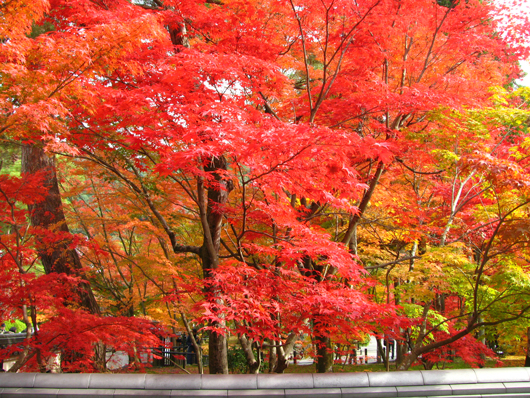< fig.1、Trios Freres cave、shaman >
This time, we look at the wonderful arts in the last of glacial epoch Europe.
These were in the fate that disappears suddenly soon.
At first, it is the Altamira cave (about 14500 years ago) in Spain.
It is close to a sea and is on a gently sloping karsts hill (altitude 160 m.).
今回は、氷河期ヨーロッパの最後を飾る素晴らしい美術品を見ます。
これらはやがて忽然と姿を消す運命にありました。
最初は、スペインのアルタミラ洞窟(約14500年前)です。
北側に海があり、標高160mのなだらかなカルスト丘陵にある。
< fig.2, the big roof >
< fig.3, a bison >
The mural paintings were concentrated in the big roof fig.2 (entering the entrance of fig.4, immediately left-hand side).There were pictures of 25 animals drew with red, black and brown.
The pictures were many bisons, deer, wild boar, horse and a person like shaman.
The stereoscopic effect and reality of bison fig.3 are increasing by many colors, gradation and shadow processing.
This is the highest level of Old-Stone-Age pictures.
It is presumed that one author drew the all pictures of the big roof, and the cave had been managed together.
Probably, the bison that emerge in abysmal darkness by a swinging torch may seem to be alive completely.
壁画が集中しているのは大天井図2(図4の入口入って直ぐ左手)で、25頭の動物絵が赤・黒・褐色で描かれている。
とくにバイソンが多く、鹿、猪、馬などのほか、呪術師らしい人物もある。
バイソン図3は、多色彩、ぼかしと陰影処理により、立体感と写実性が増している。これは旧石器時代絵画の最高水準です。
この大天井は一人の作者がすべて描いたと推定され、洞窟が共同で管理されていたことを伺わせる。
真っ暗闇の中、揺らぐ一つの灯明で浮かび上がるバイソンは、まるで生きているように見えただろう。
< fig.4,Altamira Cave、The lower left is an entrance. full length 270 m, Spain >
The first Peoples came to the cave about 19000 years ago.
The People did not live inside the cave (fig.4), but dug the hole in the cave entrance, and were making it the dumping ground.
Because of the thrown-away bone, it turned out that rich woods and many hunting animals were in the circumference of the cave.
The drawing animals accord with the hunting animals.
It seems that the peoples repeatedly used the cave as a meeting place during the long period.
Various small groups came and went the vast domain between France and Spain.
約19000年前に人々が洞窟に最初にやって来た。
人々は洞窟内部(図4)には住まず、洞窟入口内に穴を掘りゴミ捨て場にしていた。
捨てられていた骨から、洞窟周辺は豊かな森、多くの狩猟動物がいたことがわかる。
描かれている動物は、狩猟対象と一致する。
人々は長い期間を通じて何度も繰り返しそれぞれの洞窟を集合場所として使ったようである。
色々な小集団がフランスとスペインの間の広大な領域を行き来していた。
< fig.5、reindeer and fish >
< fig.6、Two bisons、full length 61cm in right-hand side>
We look at other distinctive arts from an old thing.
Fig. 5 is a developed figure of commanding sticks was made of hartshorn. This was found in Lortet cave of 17000 years ago in France.
There are a reindeer of right edge looks back, and the legs of two reindeers before it.
And the four salmons seem to poke the deer from the bottom under the legs.
Probably, this drew the spectacle in which a group of reindeer just has been going across a river to which the salmons have been ascending.
They caught the moment that they excited most. The vigorous figure was expressed by simple line engraving.
Fig. 6 shows the relief that was made of clay on the floor in Tuc d'audoubert cave of 15000 years ago in France.
One pair of bison at last minute copulation was expressed.
Fig.1 was a copy of mural painting in Trois Freres cave of 15000 years ago in France. This cave connected with the above-mentioned cave.
It is visible to shaman who imitated the figure of a deer, or the personified person.
他の特徴ある美術を古いものから見てみる。
図5は、フランス、ロルテ洞窟出土、17000年前の鹿角製指揮棒の展開図である。
右端に後ろを振り返るトナカイ、その前に2頭の脚が見える。
しかも、その足の下で、4尾の鮭が下から鹿を突いているように見える。
これは鮭が遡上している河をトナカイの群れが渡る光景を描いているのだろう。
彼らは最も興奮する瞬間を捉えた。その躍動感ある図をシンプルな線刻で表現している。
図6は、フランス、チュック・ドードゥベール洞窟、15000年前の床面の粘土製浮き彫りである。
今まさに交尾寸前の雌雄一対のバイソンを表現している。
図1は、上記洞窟と連なっているトロワ・フレール洞窟にある同時代の絵画の一部を模写したものです。それは鹿の姿を真似たシャーマか擬人化された人物に見える。
< fig.7、 line drawing carved into the rock in Addaura cave >
Fig. 7 shows the line drawing carved into the rock of about 10000 years ago in Addaura cave of Italy.
Eight persons become a round ring and dance around two lying persons in the picture.
Strangely、the dancers are wearing the mask to which a beak attached. Two persons of middle are bind a head and a leg with a rope, and their penis is rising up.
This is associated with the scene of a sacrifice.
In those days, did the ceremony that wore mask already start?
I will tell the perspective of cave arts next time.
図7は、イタリア、シチリア島のアッダウラ洞窟の線刻画(約10000年前)です。
中央に横たわる二人の周囲を8人が丸い輪になって踊る様子が描かれている。
異様なのは、踊り手は嘴のついた仮面をかぶっている。真ん中の二人は首と足を綱で縛られ、男根が勃起していることです。
これは生け贄のシーンを連想させます.
この頃、既に仮面を被った儀式が始まっていたのだろうか。
次回は、洞窟美術の全体像を語ります。
























